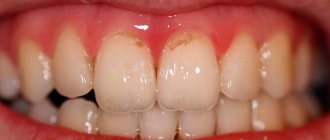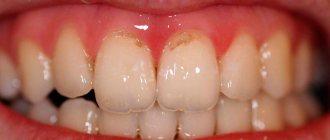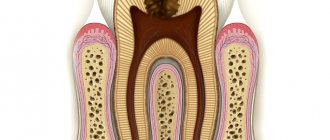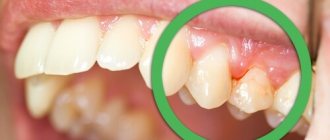Concept and reasons for origin
The term “small lower jaw” in dentistry and orthodontics has several interpretations with significant differences:
- Micrognathia (also microgenia) is a pathology manifested in the form of defective or delayed development of the entire lower jaw, as well as its individual fragments;
- Prognathia is an intensive growth of the upper part of the jaw apparatus, which results in the visual effect of insufficient development of the lower jaw.
Both pathologies manifest themselves in both infancy and adulthood. Clinical manifestations of the anomaly make it possible to detect the presence of abnormalities at the primary stages of development, which provides the possibility of preventive treatment.
In children
In infancy, improper formation of the lower jaw is caused by various factors, the main one of which is a violation of the uniform process of fetal development in the prenatal period. At this stage, the relationship of jaw proportions is established, which can be influenced by:
- improper maternal diet;
- presence of genetic predisposition;
- consumption of nicotine and alcohol products;
- exposure to serious illnesses with complications.
In the early stages of a child’s life, factors influencing the development of pathology are:
- late formation of bite;
- metabolic disorders in the body;
- early loss of baby teeth;
- bad habits (pacifiers, pacifiers);
- improper feeding.
The primary signs of small lower jaw syndrome in children are recession of the chin and lower lip, abnormal tooth growth and impaired sucking function. Timely identification of symptoms allows the anomaly to be stopped without the use of orthodontic treatment methods.
In adults
In older age, factors provoking the formation of pathology are:
- incorrect or incomplete treatment in childhood;
- receiving severe injuries to the jaw apparatus;
- disorders of the body's metabolic processes;
- pathologies formed in bone tissue (rickets, ostiomyelitis);
- abnormal development of the orbicularis oris muscle.
Characteristic manifestations of small lower jaw syndrome in adulthood are distortion of the patient’s facial features, deformation of the dentition, and problems with eating solid foods.
Signs and diagnostics
The main signs of jaw underdevelopment are visual anomalies that are visible to the naked eye. At a severe stage of microgenia, a person exhibits a “bird profile”. There are some other signs and symptoms that may indicate this pathology. These include:
- malocclusion, which is easily detected during examination by a doctor;
- “recession” of the lower lip and, as a result, a small chin;
- in some cases, a cleft in the palate may form;
- grinding down of the dentition due to constant friction, as well as curvature and uneven growth of teeth;
- difficulties while chewing food and swallowing it;
- difficulty breathing;
- underdevelopment of the tongue, which can cause it to sink when lying on your back;
- abnormal changes in the ENT organs: chronic rhinitis, deviated nasal septum, decreased sense of smell, frequent occurrence of otitis media.
It is necessary to take into account that signs of microgenia can also be observed in the presence of other pathologies. In this regard, it is necessary to conduct a complete diagnosis. The examination is carried out by a qualified dentist.
Braces can correct only mild pathology
The primary thing is to conduct a visual examination, during which the doctor will identify characteristic external signs. In the future, the patient will be referred for a panoramic image (a type of digital radiography) and tomography.
This will provide complete information about the condition of the chin and help you choose the most appropriate method for eliminating the pathology.
Treatment and prevention
The choice of treatment technique is determined by the clinical picture of the development of the pathology, as well as the age group to which the patient belongs. The main vector of therapy is to stimulate the development and growth of the lower jaw.
In childhood
The period of primary occlusion is one of the most favorable in terms of correction possibilities, since it allows the use of gentle treatment methods. The main methods used at this stage are:
- prosthetics for prematurely fallen milk teeth, ensuring the preservation of the normal shape of the jaw arch;
- sanitation of the oral cavity, accompanied by the restoration of individual damaged teeth and cleaning of defective roots;
- grinding of the areas of jaw closure - fissures - which allows you to eliminate malocclusion in the form of bumps on the chewing surface;
- normalization of breathing and tongue function, including by trimming the lingual frenulum and correcting the nasal septum;
- use of special corrective trays, plates or nipples.
Quite often, in order to stop the primary signs of pathology, it is enough to wean young children from bad habits.
As an adult
The treatment method during the period of permanent or mixed dentition is determined by the specifics of the anomaly.
To treat prognathia at the variable stage, special corrective orthodontic appliances, such as a Frenkel adjuster, a facebow or a Herbst device, can be used. Microdentia is treated with the help of distractors - devices that stretch the bone tissue and then replace it in the jaw with new bone.
At the permanent stage of occlusion, the most effective method is jaw surgery, which involves removing part of the dentition and excision of the alveolar-ridge area. It is also possible to use a radical technique - plastic surgery, in which the lower jaw is broken off from the main bone and moved forward, and in its place new bone material is placed, fixed with special plates.
The easiest way to avoid orthodontic intervention and stimulate the normal development of the lower jaw is in childhood - to do this, it is enough to follow simple preventive measures, prevent the development of bad habits and contact specialists at the first signs of pathology.
How does malocclusion appear in children?
Every parent wants their child to have strong, healthy and straight teeth, as well as a correct bite, which will provide their child with a real “Hollywood” smile. However, how early is it necessary to start prevention, when the moment of formation of the future occlusion arrives? Modern orthodontics has long ago answered this question - a beautiful, correct bite begins to form in infancy, when the child’s tissues and bones are still quite plastic and subject to deformation. Therefore, in order to avoid problems in the future, parents are strongly recommended to pay close attention to the causes of malocclusion in children and methods of prevention.
According to doctors, one of the main reasons for the formation of a pathological bite (bite pathology) is artificial feeding. The fact is that at birth, in infants, the lower jaw is always smaller than the upper and less developed; this in itself is not a pathology; on the contrary, it is the norm. When breastfeeding, the baby naturally places his jaws in the correct position to suckle from his mother's breast, which helps develop a proper bite. When feeding from a bottle, the baby does not need to exert as much effort as when breastfeeding, the load on the facial muscles is much lower and they develop more slowly. If the baby is deprived of the opportunity to breastfeed, the formation of the correct position of the jaws may be impaired, which, in turn, leads to various pathologies in the future.
In addition, it is necessary to monitor the position of the baby’s head during feeding; the baby should not throw it back, as this also adversely affects the formation of the bite. It is especially important to monitor a child’s nutrition during the formation of his first teeth. Due to a lack of calcium and phosphorus, teeth may begin to erupt much later - this is already a reason to pay attention to the correct formation of the masticatory apparatus.
The next important stage comes when the baby is introduced to solid foods instead of milk. Usually children are not very willing to switch from milk to solid food, which is natural, because for them it is something new. Many parents choose to rely on nature and not insist that their baby eat solid foods, making a very common mistake. In a child who does not eat enough solid food, the chewing apparatus does not work at full strength, the muscles of the face and jaw develop much more slowly, since, in fact, the jaws hardly work. Due to improper development of the jaw bones, the child’s teeth begin to grow incorrectly.
In addition to the above, there are several other factors that can affect a child's future smile. For example, the habit of sleeping in the same position contributes to the narrowing and displacement of the lower jaw. The following positions are considered the most “dangerous” in this case: on the stomach, on the side, placing a hand under the cheek, on the back. Of course, it is quite difficult to control postures during sleep, but you can purchase special pillows that will ensure the correct position during sleep.
Most often, malocclusion is combined with poor posture. When a child is hunched over and his head protrudes significantly forward compared to his body, this leads to underdevelopment of the lower jaw. Various bad habits, such as thumb sucking, lip biting and prolonged pacifier sucking, also have a bad effect on the bite. Parents are simply obliged to wean their child from all this on time. When a child sucks his finger, his teeth move back the width of a finger to make sucking more comfortable, and remain in this position even when the baby has grown. Such a gap between the teeth - diastema - will be quite difficult to cure in adulthood.
And one of the last reasons for the formation of malocclusion is colds. With adenoids and various inflammations, a child whose nose is constantly stuffy is forced to breathe through his mouth. Improper breathing leads to the fact that the structure of the skull is disrupted and the bite is formed incorrectly, the so-called “adenoid” type of face appears.
And finally, the last, but most serious reason is heredity. It often happens that a child inherits crooked teeth and malocclusion from his parents. In this case, it is necessary to take the child to an orthodontist from a very early age so that he can monitor the development of the jaws and at the right time can prevent the development of malocclusion.
Precautionary measures
Any health problems, including dental problems, can be prevented if you engage in timely prevention. Now we will give you some useful tips to keep your child’s teeth straight and beautiful.
- If you cannot, for some reason, breastfeed your baby, then you should not buy a regular pacifier; it is best to buy a specialized one, which in structure resembles the mother’s nipple. In such a nipple there is a very small hole and the child is forced to work hard with his jaws to get milk. Long nipples and nipples with large holes can harm the baby. In addition, when bottle feeding, it is necessary to place the baby in the same position as when breastfeeding so that the process is as natural as possible.
- Correct position while sleeping. Take the time to make sure that the child does not sleep in the same position, shift him several times during the night, very soon he will get used to it and begin to roll over on his own. It is best to choose a flat, low pillow for your baby that will not spoil his posture and bite.
- No pacifiers or thumb sucking after 9 months! It is from this age that the child must gradually wean himself from these bad habits, otherwise the risk of developing a pathological bite is very high.
- When teeth begin to appear, gradually introduce your child to solid food, he should chew something and thus develop his facial muscles. At first, the child will get tired of chewing, but this will pass quite quickly.
If you have been closely monitoring your baby, but he still has problems with his bite, contact a specialist, an orthodontist, as soon as possible. Remember, it's never too early! It is better to cure the first signs of malocclusion in childhood than to wear expensive and complex orthodontic appliances later as an adult.
How to get rid of prognathia?
Since distal occlusion is a complex dental pathology, its correction usually consists of several stages. In some cases, surgical intervention is not possible. However, this is not a prerequisite for the treatment of prognathia - modern dental technologies make it possible to solve the problem without surgery. The easiest way to treat distal occlusion is in children and adolescents, that is, during the period when the development of the dental system has not yet been completed or has just stopped.
Consequences of distal occlusion
Any violation of facial proportions removes a person’s appearance from the ideal of beauty and reduces his attractiveness. Insufficient development of the lower third of the face, an inexpressive chin, protruding teeth - all this creates an unfavorable impression of a person. In addition to this, other problems develop over time:
- diction suffers;
- the process of chewing food becomes difficult, which negatively affects the functioning of the entire digestive system;
- improper distribution of chewing load reduces the service life of teeth, leads to rapid abrasion of enamel, tooth loss due to inflammatory processes in the periodontium;
- pathological changes in the temporomandibular joints lead to the appearance of clicking sounds when chewing and become one of the causes of frequent headaches;
- If a patient has malocclusion, prosthetics becomes difficult, and the service life of crowns and dentures decreases.
Problems increase gradually, and their presence is not always associated with existing prognathia. However, it is better to think about your health when correction of the distal bite can be carried out as planned.
Why shouldn’t correcting a distal bite be postponed?
- If prognathia is not cured, over time it will not have the best effect on the appearance of the face: it will look disproportionate, acquire a constant expression of surprise, and noticeably protruding teeth will complement the not very attractive image.
- With age, people with uncorrected distal occlusion develop quite serious diction problems.
- The pathology makes it difficult to chew food thoroughly, and digestive problems appear.
- The atypical distribution of load between the teeth leads to the fact that the frontal zone is absolutely not involved in the work of the dentofacial system. The chewing teeth take on all the work, as a result of which they wear out, become inflamed and often fall out.
- Since with a distal bite the entire dentofacial apparatus functions incorrectly, in adulthood or old age people experience problems with the temporomandibular joint - the jaws begin to click when chewing, opening or closing the mouth, and chronic headaches appear.
- With prognathia, orthopedic treatment is almost impossible: the abnormal closure of the dentition does not allow for high-quality prosthetics, and the installed crowns constantly break.
Distal bite must be treated! And it is best to do this in childhood or adolescence.
Duration of treatment
The duration of correction is largely determined by the age of the patient. However, you must immediately prepare yourself for several months of wearing orthodontic structures. During the period of mixed dentition, children will have to wear special devices for a year and a half. In adults, wearing braces may take several years to obtain lasting results. However, a person quickly gets used to any devices and stops feeling them. And you shouldn’t refuse correction, since prognathia can lead to serious problems in the foreseeable future.
Reasons for the formation of pathology
The development of dentofacial curvature is based on a hereditary predisposition, which is “layered” with damaging environmental factors. It also matters what affects the child during the period of intrauterine development, and the conditions under which the formation of the dental system occurs in the first years of life. The following three factors have the greatest influence.
Features of artificial feeding
When using special orthodontic nipples or when breastfeeding, the newborn has to make efforts to get milk. The tension of the facial muscles necessary for this stimulates the correct and uniform development of the jaws. When feeding from a bottle with a regular nipple, the baby practically does not strain. Because of this, the dental-jaw system lags significantly behind in development, which becomes the “background” for the development of various anomalies.
Nasal breathing disorder
The habit of breathing through the mouth leads to elongation and excessive increase in the size of the upper jaw, while the lower jaw lags behind it in proportions. According to statistics, diseases of the ENT organs are observed in every third child with a distal bite.
Violation of the process of changing teeth
Here, the cause of the development of prognathia may be the untimely loss of baby teeth due to injury or caries, improper eruption of permanent teeth, underdevelopment or lack of formation of permanent teeth. Unfortunately, many adults underestimate the importance of timely correction of primary and secondary dentition. As a result, where it was possible to get by with a temporary prosthesis, expensive braces have to be installed.
Children who do not have fangs on the lower jaw are at risk of developing prognathia. They have a malfunction of the articulatory apparatus, and the growth of the lower jaw slows down. Implantation can help in this situation.
Predisposing factors for the development of dentofacial pathology include cases of poor posture, rickets, the habit of thumb sucking, and the use of an irregularly shaped pacifier.
Signs of malocclusion
It may manifest itself as follows:
- the lower or upper jaws protrude abnormally forward or sideways ( mesial and distal type, respectively);
- the upper incisors significantly overlap the lower ones (by more than a third) - deep type ;
- The prognathic form is similar to the previous type - the patient’s lower jaw is underdeveloped, unlike the upper;
- the teeth do not close together, as a result of which a gap is formed - open type ;
- the teeth close together in a “scissors” fashion due to unilateral underdevelopment of one of the dentitions - cross type .
We can also talk about malocclusion when there is dystopia of the teeth - their displacement to the side, abnormal rotation around an axis, complete absence, growth inward or out of place. This, for example, includes crowding, most often caused by delayed jaw growth.










